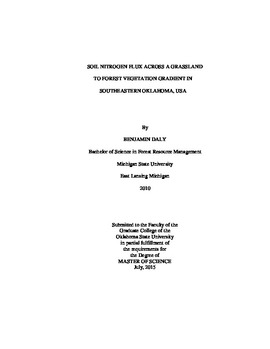| dc.contributor.advisor | Wilson, Duncan S. | |
| dc.contributor.author | Daly, Benjamin Edward | |
| dc.date.accessioned | 2016-09-29T18:39:32Z | |
| dc.date.available | 2016-09-29T18:39:32Z | |
| dc.date.issued | 2015-07-01 | |
| dc.identifier.uri | https://hdl.handle.net/11244/45245 | |
| dc.description.abstract | The Forest Habitat Research Area located in the Pushmataha Wildlife Management Area in southeastern Oklahoma provides a unique opportunity for research into vegetation effects on soil nitrogen cycling. Long term treatments combining a range of initial harvesting practices with different prescribed fire intervals have created a gradient of ecosystems from restored tallgrass prairie and savanna systems, to undisturbed closed canopy forest. Prescribed fire intervals ranged from one to four years, resulting in marked structural changes, with higher frequency fire intervals resulting in grassland or savanna structures, and longer intervals returning to a forested structure after thirty years of continuous treatment. To compare vegetation structural influences on litter decomposition rates, fresh pine foliage was deployed in litter bags placed at XX locations across the forest-grassland continuum. There was no statistical difference in decomposition rates over the XX study months. The foliage lost on average XX percent of initial mass, with no detectable differences of vegetation structure on cellulose, hemi-cellulose or lignin loss rates. In situ placed ion exchange resin beads over the same deployment interval as the litter study showed total inorganic nitrogen flux in the upper soil layer was higher in forested areas compared to grassland or savanna. Nitrate levels were similarly higher in the forest compared to the grassland or savanna. To assess differences in potential soil nitrogen flux, aerobic incubation of soil samples also showed total inorganic nitrogen flux was higher in forest soils and lowest in grassland soils. However there were no significant differences in nitrate levels. This study showed significant, although slight differences in nitrogen flux caused by savanna restoration treatments continuously applied for thirty years. The undisturbed forested treatments generally showed higher nitrogen flux, with low fire return frequency, savanna structured treatments showing somewhat higher flux rates than higher return, grassland structured treatments. | |
| dc.format | application/pdf | |
| dc.language | en_US | |
| dc.rights | Copyright is held by the author who has granted the Oklahoma State University Library the non-exclusive right to share this material in its institutional repository. Contact Digital Library Services at lib-dls@okstate.edu or 405-744-9161 for the permission policy on the use, reproduction or distribution of this material. | |
| dc.title | Soil Nitrogen Flux Across a Grassland to Forest Vegetation Gradient in Southeastern Oklahoma, USA | |
| dc.type | text | |
| dc.contributor.committeeMember | Will, Rodney E. | |
| dc.contributor.committeeMember | Wilson, Gail W.T. | |
| osu.filename | Daly_okstate_0664M_14119.pdf | |
| osu.accesstype | Open Access | |
| dc.description.department | Natural Resources and Ecology Management | |
| dc.type.genre | Thesis | |
